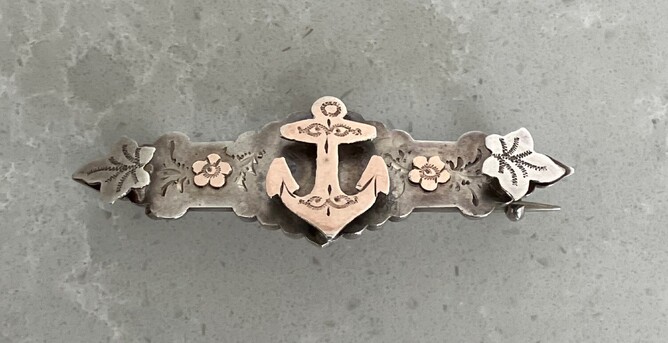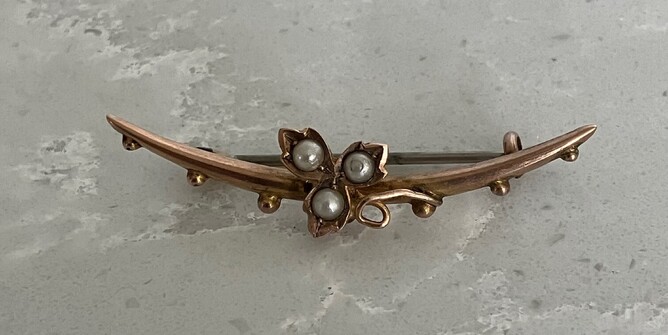A Symbol of Love and Devotion
Victorian sweetheart brooches, with their intricate designs and emotional significance, remain some of the most treasured pieces of jewellery from the 19th and early 20th centuries. Often passed down through generations, these delicate brooches represent more than just adornment—they symbolize love, affection, and the deep emotional connections that defined the Victorian era. Whether exchanged between lovers or given as tokens of friendship, sweetheart brooches hold a unique place in the history of jewellery and in the hearts of collectors today. I may have a minor obsession with them so if you search for sweetheart brooch in our shop you'll find quite a few.
The Meaning Behind Sweetheart Brooches
The term "sweetheart brooch" typically refers to a type of jewellery that was given as a gift, often as a gesture of affection or devotion. These brooches became especially popular during the Victorian period, particularly in the mid-to-late 19th century. In the context of the Victorian era, a time when outward displays of sentiment were highly valued, a sweetheart brooch was more than just an ornament; it was a physical manifestation of personal emotion.
Sweetheart brooches were commonly exchanged between lovers and were often worn as a sign of a romantic relationship. The brooch might be given as a gift before a lover went off to war or as a keepsake from an engagement. In some cases, soldiers sent sweetheart brooches back home to their partners as symbols of love and longing while they were serving overseas. The brooches thus became a part of the fabric of wartime sentimentality, linking them closely to both love and loss.
Materials and Design
Victorian sweetheart brooches were made from a variety of materials, ranging from inexpensive to quite luxurious. The designs were often influenced by the nature of the relationship or the sentiment the giver wished to express. Some brooches were crafted from precious metals like gold or silver, while others were made of more affordable materials like brass or base metals, some were embellished with enamel or gemstones.
A common feature of sweetheart brooches was the use of symbolic motifs—hearts, anchors, and flowers were popular choices. The heart was, of course, the most iconic symbol of love, but anchors could also represent steadfastness and loyalty, while flowers, such as forget-me-nots, conveyed remembrance. The brooches often had intricate engravings or sentimental inscriptions, such as initials, dates, or romantic phrases, adding a personal touch that made them all the more meaningful.
One of the most recognizable types of sweetheart brooches are those that incorporate small sections of lockets or photo holders. These brooches were designed to hold a tiny photograph or lock of hair of the person who gave or received the brooch, making it a wearable keepsake. The brooch became a way for loved ones to carry a physical reminder of each other, even when they were apart.
Sweetheart Brooches and Military History
The connection between sweetheart brooches and wartime sentiment is perhaps one of the most poignant aspects of their history. The British Empire was involved in various wars and conflicts, and many soldiers sent sweetheart brooches to their loved ones as tokens of their affection before heading off to battle. This practice was especially prevalent during the Crimean War (1853-1856) and the First World War (1914-1918).
The Victorian obsession with sentimentality, combined with the frequent separations caused by war and also migration created a demand for keepsake jewellery that could hold deep emotional meaning. Sweetheart brooches became a symbol of both the hope of reunion and the sorrow of separation. Many of these brooches were often inscribed with the names of soldiers, along with their regimental insignia or other military symbols, which made them especially treasured by the women who received them. Others bore the names of the recipient, so you might come across one with your own name - particularly if it was popular during the Victorian period.
The brooches served as a daily reminder of the love and loyalty between a soldier and his sweetheart, even if they were miles apart. In some cases, these brooches were passed down as family heirlooms, preserving not only the memory of the individual soldier but the historical and emotional context of the period.
The Revival of Sweetheart Brooches
Today, Victorian sweetheart brooches continue to captivate collectors and jewellery enthusiasts alike. Whether admired for their delicate craftsmanship, sentimental value, or historical significance, these brooches remain an enduring symbol of Victorian romance. Many people still seek out these brooches as gifts for loved ones, cherishing the timeless sentiment they represent. Those made in base metals or even silver are often quite well priced. Personally, I'm drawn to the silver ones as English ones are hallmarked helping me to place them in their historical timeline. Sometimes small decorative elements are overlaid in gold on silver brooches, much like the gold shields that often appear on fob medals from the same period.
Whether in antique shops or at estate sales, Victorian sweetheart brooches can often be found, offering a glimpse into the past and the enduring power of love and memory.
Victorian sweetheart brooches are more than just beautiful pieces of jewellery; they are poignant symbols of love, affection, and loss. Whether exchanged between lovers or kept as cherished mementos, these brooches encapsulate the emotions and values of a bygone era. Their intricate designs, emotional significance, and historical context make them timeless treasures—reminding us of the power of sentiment and the lasting bond between those who care for one another. If you’re lucky enough to own one, or if you come across one in your travels, remember that you're holding more than a piece of jewellery; you’re holding a piece of history.



